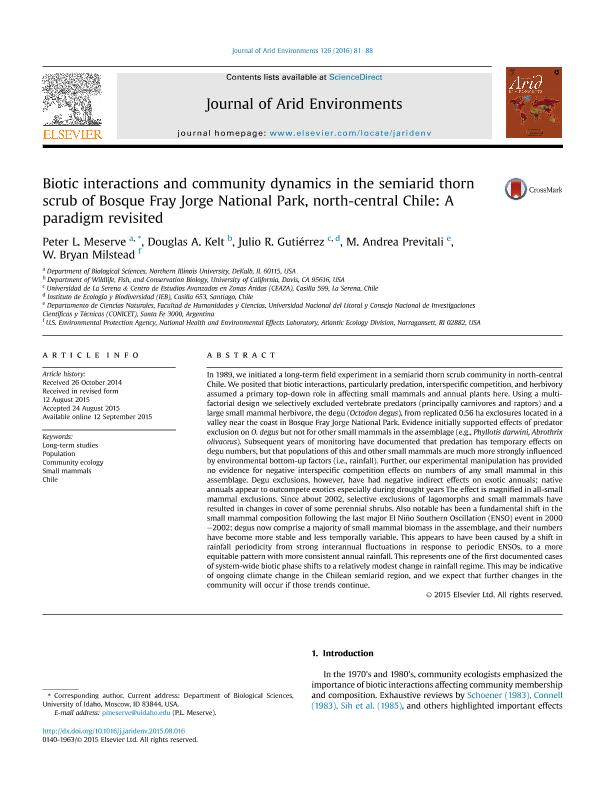Artículo
Biotic interactions and community dynamics in the semiarid thorn scrub of Bosque Fray Jorge National Park, north-central Chile: A paradigm revisited
Meserve, Peter L.; Kelt, Douglas A.; Gutiérrez, Julio R.; Previtali, Maria Andrea ; Milstead, W. Bryan
; Milstead, W. Bryan
 ; Milstead, W. Bryan
; Milstead, W. Bryan
Fecha de publicación:
09/2015
Editorial:
Academic Press Ltd - Elsevier Science Ltd
Revista:
Journal of Arid Environments
ISSN:
0140-1963
Idioma:
Inglés
Tipo de recurso:
Artículo publicado
Clasificación temática:
Resumen
In 1989, we initiated a long-term field experiment in a semiarid thorn scrub community in north-central Chile. We posited that biotic interactions, particularly predation, interspecific competition, and herbivory assumed a primary top-down role in affecting small mammals and annual plants here. Using a multi-factorial design we selectively excluded vertebrate predators (principally carnivores and raptors) and a large small mammal herbivore, the degu (Octodon degus), from replicated 0.56 ha exclosures located in a valley near the coast in Bosque Fray Jorge National Park. Evidence initially supported effects of predator exclusion on O. degus but not for other small mammals in the assemblage (e.g., Phyllotis darwini, Abrothrix olivaceus). Subsequent years of monitoring have documented that predation has temporary effects on degu numbers, but that populations of this and other small mammals are much more strongly influenced by environmental bottom-up factors (i.e., rainfall). Further, our experimental manipulation has provided no evidence for negative interspecific competition effects on numbers of any small mammal in this assemblage. Degu exclusions, however, have had negative indirect effects on exotic annuals; native annuals appear to outcompete exotics especially during drought years The effect is magnified in all-small mammal exclusions. Since about 2002, selective exclusions of lagomorphs and small mammals have resulted in changes in cover of some perennial shrubs. Also notable has been a fundamental shift in the small mammal composition following the last major El Niño Southern Oscillation (ENSO) event in 2000?2002; degus now comprise a majority of small mammal biomass in the assemblage, and their numbers have become more stable and less temporally variable. This appears to have been caused by a shift in rainfall periodicity from strong interannual fluctuations in response to periodic ENSOs, to a more equitable pattern with more consistent annual rainfall. This represents one of the first documented cases of system-wide biotic phase shifts to a relatively modest change in rainfall regime. This may be indicative of ongoing climate change in the Chilean semiarid region, and we expect that further changes in the community will occur if those trends continue.
Palabras clave:
Long Term Studies
,
Populations
,
Community Ecology
,
Small Mammals
Archivos asociados
Licencia
Identificadores
Colecciones
Articulos(CCT - SANTA FE)
Articulos de CTRO.CIENTIFICO TECNOL.CONICET - SANTA FE
Articulos de CTRO.CIENTIFICO TECNOL.CONICET - SANTA FE
Citación
Meserve, Peter L.; Kelt, Douglas A.; Gutiérrez, Julio R.; Previtali, Maria Andrea; Milstead, W. Bryan; Biotic interactions and community dynamics in the semiarid thorn scrub of Bosque Fray Jorge National Park, north-central Chile: A paradigm revisited; Academic Press Ltd - Elsevier Science Ltd; Journal of Arid Environments; 126; 9-2015; 81-88
Compartir
Altmétricas



